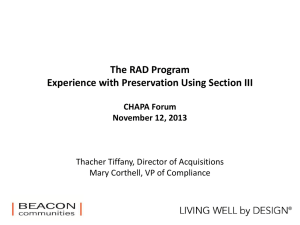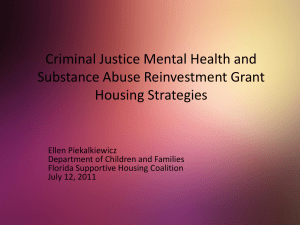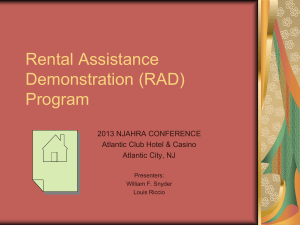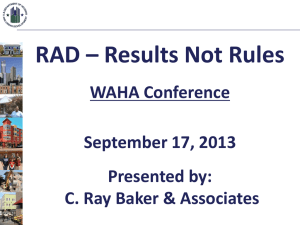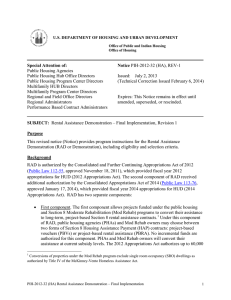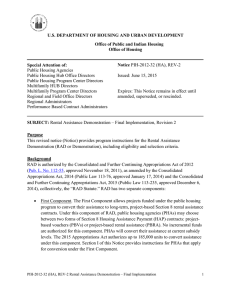Rental Assistance Demonstration (RAD)
advertisement
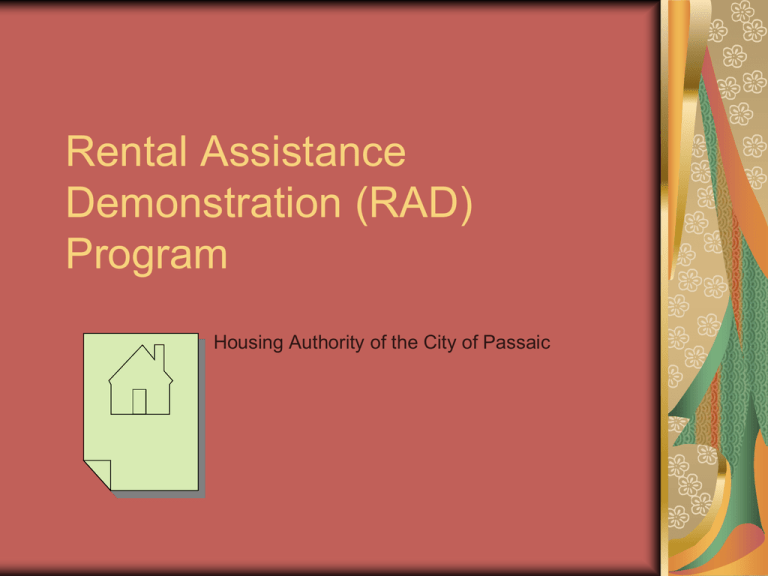
Rental Assistance Demonstration (RAD) Program Housing Authority of the City of Passaic Presenter William F. Snyder-Consultant Victor Cirilo, Executive Director HUD Notice PIH 2012-32 Issued 7/26/12 Provide Instructions for the RAD program Eligibility Selection Criteria What is RAD RAD converts the current public housing program Annual Contributions Contract (ACC) into a Project Based Voucher (PBV) or Project Based Rent Assistance (PBRA). Passaic Housing Authority PHA previously applied for conversion for all elderly units (130 units at 3 sites). PHA one of 3 original Housing Authorities to get HUD approval of its RAD application PHA anticipates completing the transaction by early 2014. I Will be providing approximately $5,900,000.00 in rehabilitation to the 3 projects ($45,000.00 per unit). It will take 2 years, after conversion, to complete the rehab work PHA Current Consideration Conversion of all housing under the RAD program Alfred Speer Village-384 units Vreeland Village-116 units Chestnut Gardens-70 units Total additional units: 570 What will this mean for you? There will be little effect on the residents. Rent will remain the same You will not have to move out of your unit during the rehabilitation work What will this mean for your? Rehabilitation approximately $25 million dollars to make repairs at all locations. Funding provides 75% of total capital need. The balance can be funded over a 20 year period via replacement reserve. Current estimated need $33.7 million It is an alternative to mixed finance (Choice Neighborhood) Current PHA need-Per PNA $33,663,748-Total Capital Need Speer Village-384 units $21,969,000.00 Capital Need $56,500 per unit Vreeland Village-116 units $6,909,523.00 Capital Need $59,565 per unit Chestnut Gardens-70 units $4,785,225.00 Capital Need $68,360 per unit Where are we going with the public housing program? The trend does not seem to indicate an increase in federal funding anytime soon! All of funding for our buildings comes from HUD from 2 major sources: Operating Fund Capital Fund “Proration Factor” The Annual Contributions Contract (ACC) stipulates that your subsidy is subject to annual appropriations from Congress. There is currently an $800,000,000.00 gap in PHA Operating Fund eligibility and Congressional appropriations. PHAs must estimate what percentage Congress will approve in preparing their budget. The “Proration Factor” Operating Fund For 2012, the Congress accepted the Administration’s recommendation and funded the Public Housing Operating Fund at $3.982 billion, $1 billion below total subsidy eligibility. This funding level was paired with a $750 million offset against “excess” existing operating reserves held by Public Housing Authorities (PHAs). . A year-long CR at the 2012 level will provide only 83 percent of PHAs’ operating costs for calendar year 2013. This is the deepest proration in the program’s history. 2014 is forecast at the same level. Capital Fund Status Estimated Need (Abt) $26 Billion Annual Accrual Rate $3.6 Billion 2013 Appropriation $1.78 Billion 25% Cut in CFP from 2010-2012 Capital Fund Program Capital Fund Program For 2012, the Public Housing Capital Fund was funded at $1.875 billion, the lowest funding level in the history of the program. Between 2010 and 2012, the Capital Fund experienced an unprecedented 25 percent reduction from what was already an inadequate funding level given the inventory’s annual accrual of capital needs. According to the Capital Needs Assessment recently completed by Abt Associates at HUD’s direction, the portfolio already has a modernization backlog in excess of $26 billion, with an annual accrual rate of approximately $3.4 billion. National Debt Current Federal Budget $3.8 Trillion Current National Debt $16.8 Trillion Current annual budget deficit $973 Billion Proposed Budget Savings over the next 10 years $1.5 Trillion “Sequestration” What is sequestration? Sequestration is an across-the-board reduction in Federal budgetary resources in all budget accounts that have not been exempted by statute. Under the Balanced Budget and Emergency Deficit Control Act of 1985, as amended by the Budget Control Act of 2011, the American Taxpayer Relief Act of 2012, and other relevant legislation, across-theboard reductions of $85 billion in budgetary resources were required to be ordered by the President on March 1, 2013. Sequestration reduces each agency’s budgetary resources in non-exempt accounts for the remainder of the fiscal year (which runs through September 30, 2013). It results in an additional 5% across the board cut in all discretionary spending programs HUD is considered discretionary spending “Sequestration” What will be the impact of sequestration on HUD? HUD will attempt to minimize the impact of sequestration to the extent permitted by law. However, HUD cannot choose which programs to exempt or what percentage cuts to apply. This will mean automatic and across-the-board budget cuts at HUD. The impact of sequestration on HUD programs will be dramatic. An approximate 5% across the board cut in HUD programs added to the already historic low proration factor! “Sequester” The sequester was originally passed as part of the Budget Control Act of 2011 (BCA), better known as the debt ceiling compromise. It was intended to serve as incentive for the Joint Select Committee on Deficit Reduction (the “Supercommittee”) to come to a deal to cut $1.5 trillion over 10 years. If the committee had done so, and Congress had passed it by Dec. 23, 2011, then the sequester would have been averted. No compromised deal has been achieved. RAD Goals Build on the proven Section 8 platform Leverage private capital to preserve assets Offer residents greater choice and mobility Selection of PBA or PBRA PBA Project Based Rental Assistance will be administered by the agency on whose Annual Contribution Contract the voucher were assigned (most cases will be the agency doing the conversion) Term-15 years (up to 20 with approval of administering voucher agency) PBV rents will be equal to current finding subject to a cap and will be adjusted annually PBA contract will also carry a concurrent renewable RAD User Agreement Must provide Choice Mobility Option to residents Maximum PBA assistance (20% of budget authority) will not count against the PHA’s maximum for covered projects Cap on Number PBV Units in each project. The 25% limitation on the number of PBV assistance in a project is increased to 50%. 100% of the units may be PBV if the at least 50% of the units qualify as elderly, disabled or families receiving supportive services. Selection of PBA or PBRA PBRA Project Based Rental Assistance-the project will be administered by HUD’s Office of Housing PBRA Contract rents will be equal to the project’s current funding, subject to a cap and will be adjusted annually Term-20 years PBRA Contract will also carry a concurrent 20 year renewable RAD User Agreement A Choice Mobility Option will be a condition of the conversion Eligibility for Conversion to RAD Must have public housing units under ACC Be classified as a standard or high performer. If “troubled” must be able to demonstrate the capacity to carry out a successful conversion. Be classified as standard or high performer under SEMAP if administering the PBV contract. If “troubled” must be able to demonstrate the capacity to carry out a successful conversion. Be in substantial compliance with HUD reporting and programmatic requirements and/or be in compliance with an MOA. Not have debarments, suspension or LDPs lodged against the Executive Director. Board members or affiliates. Submit a completed application that complies with the RAD instructions Be in compliance with all fair housing and civil rights requirements PHA QUALIFIES FOR CONVERSION! Rehabilitation & Financing Consideration HUD estimates that there is a need for approximately 25.6 billion in capital needs across the portfolio One of the main purposes of the RAD program is demonstrate how the conversion to Project Based Assistance can generate access to private debt and equity to address immediate and long-term capital needs through rehabilitation. Any and all viable forms of debt and equity financing will be considered to support the conversion. Rehabilitation Needs Applications will be scored on a perunit capital cost value system High Need Scoring: Family-$37,665 Elderly-$21,834 We are proposing in excess of $40,000 per unit Rehabilitation Consideration Physical Condition Assessment (PCA) Projects selected for award will be required to perform a detailed physical inspection of the property to determine short-term rehabilitation needs and long term capital needs to be funded through a reserve for replacement. The PCA Statement of Work must be in the format utilized in HUD’s Mark to Market program and may accessed at: http://portal.hud.gov/hudportal/hud?src=/program_offices/housing/mfh/presr v/mhrpaes/training Rehabilitation Consideration Temporary Relocation-Any temporary relocation must comply with the Uniform Relocation Assistance and real Property Acquisition Act of 1970 (see 49 CFR Part 24). Financing Consideration RAD projects are eligible for financing from private and public lending sources (see application proforma). Loans are secured according to the RAD User Agreement that will be filed in first position. Debt Service Coverage must be at least 1.11 or the lender's requirements HOME funds can be use in RAD projects Financing Considerations Low-Income Housing Tax CreditsApplicants are encouraged to use LIHTCs to support recapitalization of the project (9% & 4%). Applicants should indicate in their application that they intend to use LIHTCs. There is no requirement that the credit be secured prior to submitting an application. The 9% credit have special application requirements. Amendment to Annual & Five Year Plan (Should be done immediately!) Conversion to the RAD Program is considered a significant amendment to the PHA’s Five Year Plan for both qualified and non-qualified PHA. RAD Conversion is subject to the Consolidated Plan requirements and public notice and Resident Advisory Board consultation requirement per 24 CFR Part 903. Policy changes must be submitted to HUD within 60 days of CHAP delivery. Public notice and at least one public hearing Plan Amendments Must include the following: A description of the units to be converted, including type of units (family, elderly, etc) and bedroom distribution. Any change in the number of units, including the de minimis unit reduction (5% or 5 units). Any change in bedroom distribution Any change in policy governing admission, eligibility, selection and occupancy after conversion (including waiting list preferences). Transfer of assistance where the converted units will be moved to another location HUD will review all amendments for civil right, executive order and regulatory compliance. Resident Provisions (Attachment 1B.2-Pages 75-78) Residents must be notified and have an ability to comment on the conversion in writing. Resident comments must be responded to. Resident meetings must be held during the conversion process. Similar to Demo/Dispo process Rent Calculation Once you convert to RAD, the Housing Authority will no longer receive Operating or Capital Fund subsidies. The OF and CF are built into the monthly rent and subsidized through the Housing Choice Voucher Program (S8) RAD Application Filed at: RADapplication@hud.gov RAD Board Approval Form-includes the proposed pro-forma and other key certifications and must be approved by the Board of Commissioners and signed by the authorized representative. Financing Letter of Interest/Intent-from each lender or equity investor indicating that the proposed pro-forma is reasonable. This is not necessary where the long-term capital needs are being met from a reserve for replacement. Mixed Finance Affidavit-is required where the PHA is requesting to convert public housing to a mixed finance project. Choice Mobility Letter-signed by the voucher agency that has committed to provide Choice Mobility vouchers. This is not necessary where the PHA is meeting this requirement through turnover in their own voucher program. Designation of PBV Administering agency-the PHA must identify the agency that will be administering the PBV contract (signed letter from the administering agency) Resident consultation-include responses to comments received in connection with the resident meetings on the proposed conversion to RAD All required materials (Including attachments) must be submitted electronically using the Excel-based RAD application. Attachments must be included as PDF files. NO PAPER OR FAX SUBMISSIONS AREV PERMITTED. There is no cap on the number of applications that a PHA can file. Ranking Factors Summary of Ranking Factors Points High Capital Need 0-50 Choice Mobility Factor 20 Green Building & Energy Efficiency 10 PHA Priority 20 TOTAL 100 CHAP Milestones (Commitment to Enter into a Housing Assistance Payment Contract) All PHAs will be notified of their selection via issuance of an award letter, signed by HUD. Attached to the award letter will be a Commitment to Enter into a Housing Assistance Payment (CHAP) which will indicate HUD-approved terms and conditions for the conversion. CHAPs are not subject to negotiation by the PHA or a third party. The PHA has 15 days in which to notify HUD that they are refusing to terms of the CHAP. Does it Make Sense for your to consider RAD Conversion? This is a decision that rest with each individual PHA at each individual project. Consideration should be given to what funding will be in the future! Consideration should be given to your rehabilitation needs. Do we do all projects or selected projects? Is this a viable alternative to mixed finance? Is HUD going to eventually required that all PHA convert to the RAD system? Question & Answers Thank-you for participating!

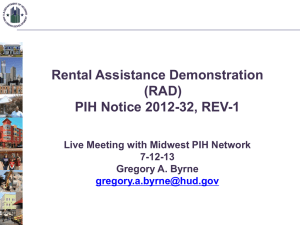
![RAD PPT Michigan Presentation 5.9.13.ppt[...]](http://s2.studylib.net/store/data/005346357_1-710f69a00abbbbdd4222e30f9215f0c5-300x300.png)

![RAD Inventory Assessment Tool for PHAs.d[...]](http://s3.studylib.net/store/data/009534164_1-662cb19c4d031e223487dfa771763564-300x300.png)
